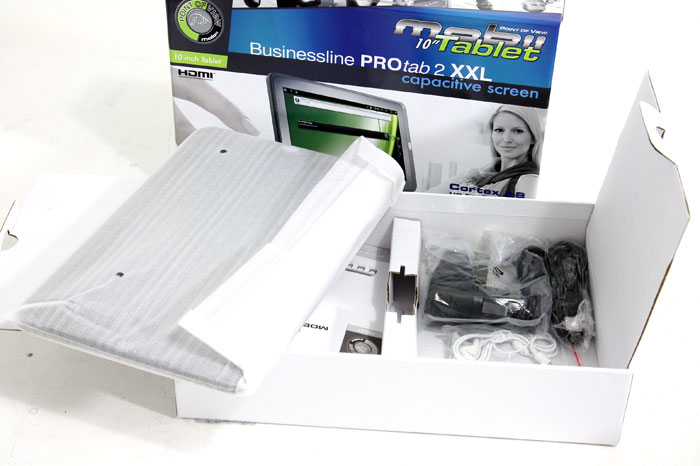Software
Software
The ProTab2XXL runs with Android 2.3 (Gingerbread), one of the bigger downsides is that we do not expect any updates for this product, and we'd really like to have seen it with Honeycomb or even better ICS. For those that don't follow the Android operating system that much here is an overview:
Android 1.5 - CupcakeCupcake was the first major overhaul of the Android OS. The Android 1.5 SDK was released in April 2009 and brought along plenty of UI changes, the biggest probably being support for widgets and folders on the homescreens. Cupcake brought features like improved Bluetooth support, camcorder functions, and new upload services like YouTube and Picasa.
Android 1.6 - Donut
Released in September 2009, built on the features that came with Android 1.5, and expanded them. While not very rich in the eye-candy department, Android 1.6 made some major improvements behind the scenes, and provided the framework base for the amazing features to come. To the end user, the two biggest changes would have to be the improvements to the Android Market, and universal search. Behind the screen, Donut brought support for higher resolution touchscreens, much improved camera and gallery support.Android 2.0/2.01/2.1 - Eclair
Eclair was a major step up over its predecessors. Introduced in late 2009, Android 2.0 first appeared on the Motorola Droid, bringing improvements in the browser, Google Maps, and a new user interface. Google Maps Navigation also was born in Android 2.0, quickly bringing the platform on par with other stand-along GPS navigation systems. Android 2.0 quickly gave way to 2.0.1, which the Droid received in December 2009, mainly bringing bugfixes. And to date, the Droid remains the phone phone to have explicitly received Android 2.0.1.Android 2.2 - Froyo
Android 2.2 was announced in May 2010. The single largest change was the introduction of the Just-In-Time Compiler -- or JIT -- which significantly speeds up the phone's processing power. Along with the JIT, Android 2.2 also brings support for Adobe Flash 10.1. That means you can play your favorite Flash-based games in Android's web browser. Froyo brought native support for tethering, meaning you could use your Android smartphone's data connection to provide Internet (wirelessly or with a USB cable) to just about any device you want.Android 2.3-2.4 - Gingerbread
Android 2.3 came out in December 2010, Gingerbread brings a few UI enhancements to Android, things like a more consistent feel across menus and dialogs, and a new black notification bar, but still looks and feels like the Android we're used to, with the addition of a slew of new language support. Gingerbread brings support for new technology as well. NFC (Near Field Communication) is now supported, and SIP (Internet calling) support is now native on Android. Further optimizations for better battery life round out a nice upgrade. Android 2.4 also is in the Gingerbread family.Android 3.X - Honeycomb
Android 3.0 came out in February 2011. It's the first version of Android specifically made for tablets, and brings a lot of new UI elements to the table. Things like a new System bar at the bottom of the screen to replace the Status bar we see on phones, and a new recent applications button are a great addition for the screen real estate offered by Android tablets. Some of the standard Google applications have also been updated for use with Honeycomb, including the Gmail app and the Talk app. Both make great use of fragments, and the Talk app has video chat and calling support built in. Under the hood, 3D rendering and hardware acceleration have been greatly improved.Andoid 4.x - Ice Cream Sandwich
The follow-up to Honeycomb has been announced at Google IO in May 2011. Dubbed Ice Cream Sandwich, Google declined to give the version number but said it would bring elements of Honeycomb tablets to smaller-screened smartphones.
So back to the ProTab2XXL, you can see why we really would have loved to see Honeycomb support. But Gingerbread it is. The OS has been left pretty much intact with minor touches here and there. It reminds me very much of my Sony Experia X10 which is stuck at Gingerbread as well.


